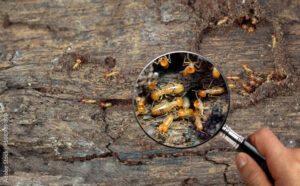
Right now, there could be thousands of termites silently working their way through your home, and you wouldn’t even know it. These tiny pests are masters of teamwork, operating through an intricate system of communication that allows them to find food, build tunnels, and—unfortunately for homeowners—cause massive destruction.
Termites don’t just chew wood; they break it down with the help of bacteria in their guts, making them nature’s original recyclers. The problem? When it’s your house they’re “recycling,” the damage can be devastating. What makes them so efficient is their ability to communicate through pheromones and vibrations, alerting the entire colony to food sources and danger in real time.
By the time you see the signs—hollowed-out wood, discarded wings, or sagging floors—it could already be too late. Understanding how termites work is the first step in stopping them before they turn your home into their next meal.
How do termites communicate with each other inside a colony?
Termites communicate with each other inside a colony using a variety of methods, primarily based on chemical signals. Here’s how they do it:
- Pheromone Release: Termites rely heavily on pheromones—chemical signals released by individuals to influence the behavior of others. These pheromones alert other termites about food sources, danger, or reproductive readiness.
- Trophallaxis (Food Sharing): Termites engage in trophallaxis, exchanging food and saliva. This exchange also carries chemical signals, helping spread information about the colony’s needs, such as a new food source or distress signals from damaged areas.
- Vibrational Communication: Termites also communicate through vibrations. Worker termites, for example, may create subtle vibrations by tapping their heads against the walls of their tunnels or nests, signaling to others about potential threats or the need to swarm to a new area.
- Chemical Trail Marking: Workers leave chemical trails as they forage for food, which other termites follow. These trails are essential for locating new food sources, like wood, and help ensure efficient foraging throughout the colony.
- Royal Court Signals: The queen and king within the colony emit specific pheromones that signal their reproductive status, maintaining colony cohesion and preventing other termites from reproducing.
This intricate communication system ensures that termites can work together efficiently, making them one of the most successful and destructive insect species.
What are the early signs of termite damage in a home?
Early signs of termite damage in a home can be subtle but are important to catch before the infestation becomes severe. Here are some of the most common early warning signs:
- Wood Sounds Hollow: Knock on wooden structures like beams or baseboards. If the wood sounds hollow, termites may have tunneled inside and consumed the wood from the inside out.
- Mud Tubes on Walls: Termites build mud tubes to protect themselves while traveling between their colony and food sources. These tubes often appear along foundation walls or crawl spaces and can be a sign of termite activity.
- Visible Wings: Swarmers, or winged termites, often shed their wings once they’ve mated and found a new place to establish a colony. Finding piles of discarded wings near windowsills or doors indicates that termites have entered your home.
- Frass (Termite Droppings): Drywood termites leave behind tiny, pellet-like droppings known as frass. If you notice small, dark pellets around wooden furniture or floors, it could signal an active termite infestation.
- Peeling Paint: Paint that looks bubbled or peeling could indicate moisture from termites feeding on the underlying wood, causing it to warp and disrupt the paint.
- Swarms or Termite Sightings: Seeing live termites or witnessing a swarm of flying termites around the home’s exterior suggests that the infestation may be more established.
If you notice these signs, it’s essential to seek professional pest control to prevent further damage and ensure your home remains safe.
Why are termites considered one of the most destructive pests?
Termites are considered one of the most destructive pests due to their ability to silently and steadily damage structures over long periods. Here’s why they are so destructive:
- Wood Consumption: Termites primarily feed on wood and cellulose, common components of home structures such as beams, floors, and walls. As they feed, they weaken the structural integrity of the home, which can result in severe damage or even collapse if left untreated.
- Colonies Can Grow Large: A termite colony can number hundreds of thousands, enabling them to consume large amounts of wood rapidly. With such a high population, termites can spread throughout a home, affecting multiple areas simultaneously.
- Silent Damage: Termites often cause damage in hidden spaces, such as inside walls or under floors. Since they work behind the scenes, homeowners may not notice the damage until it’s significant, making early intervention difficult.
- Difficult to Detect: Unlike other pests, termites don’t leave visible signs of their presence until substantial damage has occurred. This makes it challenging to catch infestations early and take preventive measures.
- Rapid Reproduction and Expansion: Termites reproduce quickly, and their colonies can expand over time, causing long-term, persistent damage that can be costly to repair.
- Risk of Secondary Issues: As termites damage wood, it may lead to the growth of mold, increased humidity, and weakened foundation structures, which create additional complications for homeowners.
These factors combined make termites one of the most damaging pests, capable of destroying homes and causing thousands of dollars in repairs.
How do termites locate and consume wood structures?
Termites have a highly efficient method of locating and consuming wood structures, driven by their powerful communication and foraging techniques. Here’s how they do it:
- Use of Pheromones: Termites rely on chemical signals to communicate and mark their paths. As they search for food sources like wood, worker termites leave a trail of pheromones that others follow, guiding the colony toward the food.
- Detecting Wood Through Vibration: Termites can detect vibrations in the ground and surrounding environment, which helps them locate potential food sources. Once they sense vibrations from wooden structures, they will investigate further and begin to tunnel.
- Tunneling and Mud Tubes: Termites create mud tubes traveling between their colony and food sources, protecting themselves from predators and dehydration. These tubes reach wooden structures hidden in walls or under the floor.
- Feeding Process: Once termites reach a wooden structure, they feed by burrowing into the wood. Worker termites have strong jaws that can scrape and chew through wood fibers. They consume cellulose, the primary material in wood, and continue to tunnel through the structure.
- Colonial Efficiency: The colony operates efficiently, with thousands of termites working together to quickly consume large amounts of wood. As they feed, they leave behind small holes, mud trails, and waste, which can signal an infestation.
Termites’ ability to detect and consume wood structures allows them to cause extensive damage silently, often before the homeowner even notices their presence.
Uncover How Termites Communicate and Destroy Your Home!
At Freedom Pest Services, we understand the hidden dangers termites pose to your home. These silent invaders communicate and work together to cause extensive damage by feeding on wood and other cellulose materials, often without detection. Our expert team is trained to identify early signs of termite infestations and implement effective solutions to protect your home. Don’t let termites compromise the integrity of your property. Contact us today to learn how we can help you safeguard your home and prevent costly damage!
